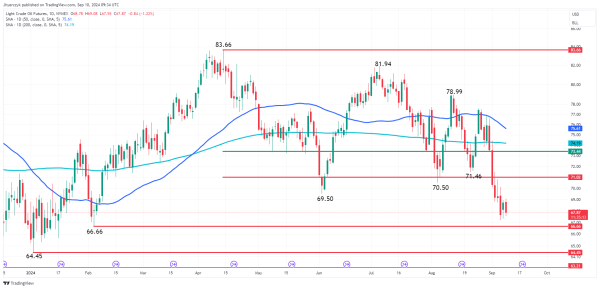Oil News: Crude Prices Fall as Weak Chinese Demand Pressures Market Outlook
Oil Prices Slide as Weak Chinese Demand Offsets U.S. Supply Disruptions

Light crude oil futures saw a sharp drop on Tuesday, drawing closer to the February 5 bottom of $66.66. If this level fails to hold, prices could further decline towards $64.45. Despite some market sentiment that crude may be oversold, the absence of a significant reversal pattern suggests that downward pressure may persist. The market remains distant from the key resistance zone between $71.02 and $73.44, with the 200-day moving average also far at $74.19.
At 09:42 GMT, Light Crude Oil futures are trading $67.72, down $0.99 or -1.44%.
China’s Weak Demand Puts Pressure on Prices
Weak demand from China continues to weigh heavily on global crude markets. Recent data has shown that China’s domestic demand remains fragile despite inflation accelerating in August to a six-month high. Furthermore, China’s exports grew at their fastest pace in nearly 18 months, but imports, including crude oil, have lagged, reflecting a cautious consumer base. Year-to-date, China’s crude imports are trailing last year’s levels by more than 3%, amplifying concerns about the country’s overall demand.
The latest trade figures have reinforced existing fears that the world’s second-largest oil consumer is not absorbing enough crude, contributing to downward pressure on prices. ING’s head of commodities strategy, Warren Patterson, highlighted that these declines in Chinese imports have been a recurring theme, keeping demand concerns at the forefront of market sentiment.
U.S. Supply Disruptions Provide Limited Support
In the U.S., Tropical Storm Francine has caused disruptions along the Gulf of Mexico, with ExxonMobil, Shell, and Chevron halting operations at multiple offshore platforms. The storm has prompted the closure of several ports, including Brownsville, and threatens to disrupt an estimated 125,000 barrels per day of oil production, according to ANZ analysts.
While the storm has created short-term supply concerns, these are being overshadowed by broader market forces. The port of Corpus Christi remains open but under restrictions, and with production likely to resume shortly after the storm, the supply disruptions may not provide enough upward pressure to counterbalance weak demand.
Global Supply Risks and OPEC Report in Focus
Looking ahead, traders are keeping a close eye on the upcoming OPEC monthly report, which could provide insights into how the organization plans to address global oversupply concerns. Additionally, the U.S. Energy Information Administration (EIA) will release its short-term energy outlook, which could further shape market expectations for global supply and demand trends.
Global trading firms such as Gunvor and Trafigura have indicated that they expect oil prices to hover between $60 and $70 per barrel, driven by weak Chinese demand and persistent global oversupply. This range reflects the market’s cautious outlook, with potential for further downside if demand conditions in China fail to improve.
Market Forecast: Bearish Outlook Amid Weak Demand
Given the confluence of weak demand from China, expectations of global oversupply, and the limited impact of U.S. supply disruptions, the outlook for crude oil prices remains bearish in the near term. With key support levels under threat and no significant signs of a reversal, traders should brace for further downside pressure, particularly if OPEC’s upcoming report and U.S. data reinforce the oversupply narrative. Prices could continue to test the $66.66 level, with further declines towards $64.45 becoming a possibility if demand remains tepid.